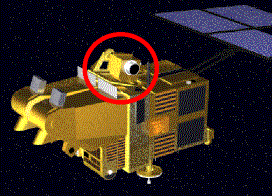
What
are PASTEL and SILEX?
Why use a laser link?
SILEX : what is it used for?
PASTEL: what does it consist of?
SILEX: how is it implemented
from the ground?
SILEX: how does it work in
orbit?
PASTEL, which stands for PAssager SPOT de TÚcommunication Laser, is one of the two optical terminals making up the space communications system, SILEX: (Semi conductor Intersatellite Link EXperiment).
 The
SILEX system was developed for the European Space Agency by Matra Marconi Space.
The
SILEX system was developed for the European Space Agency by Matra Marconi Space.
It provides a laser link between the PASTEL optical terminal on SPOT 4 and the OPALE optical terminal, mounted on the geostationary satellite ARTEMIS, which has been placed in orbit in 2001.
The information carried between PASTEL and OPALE is modulated at 50 Mbits/sec and
relayed to the ground (Toulouse) by the K-band payload on ARTEMIS.

The choice of a laser rather than a radio link is due to the potentially higher transmission rates offered by laser technology: Radio transmission is in fact limited to less than 250 Mbits/sec while, even given the current state of laser technology, it is possible to achieve rates of 10 Gbits/sec!
Laser links have another advantage, in that by their very nature, there can be no interference between optical and radio transmissions.
The SILEX experiment has a twofold objective: validation of the laser transmission concept and operational transmission of SPOT 4 imagery to the ground.
This type of optical communication, which is the first European demonstration of laser communications, is a real technological challenge.
The difficulty involves aligning and stabilizing two terminals which are on average 38 500 km away from each other, with a pointing error of less than 2 micro-radians. In other words, the beam from PASTEL (which at that distance, would have a diameter of 200 m) would have to be kept centred on OPALE with a tolerance of +/- 38m. To better grasp the difficulty involved, let us just say that it would be equivalent to hitting an orange with a rifle shot from 51 km!
This pointing is made even more difficult because:
During operations, PASTEL is used to send SPOT 4 imagery via an optical link. This could either be done directly or later by dumping of data from SPOT 4's onboard solid-state memory.
It should be remembered that without PASTEL,
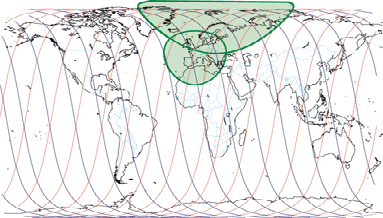
Areas of direct image acquisition without PASTEL
With PASTEL,
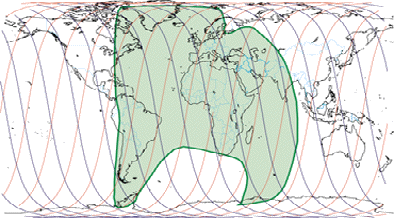
Areas of direct image acquisition with PASTEL
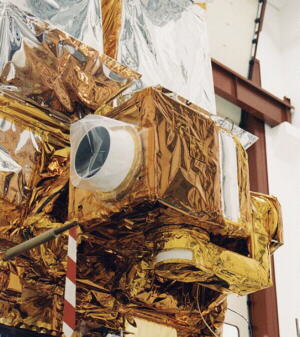 To ensure that the gimbal-mounted assembly is as light as possible, the
PASTEL terminal was divided into two sub-assemblies:
To ensure that the gimbal-mounted assembly is as light as possible, the
PASTEL terminal was divided into two sub-assemblies:
- a telescope,
- an optical bench with a fine pointing system, a communication sensor and laser diodes,
- a thermal control system for precision temperature control,
- a two-axis gimbal mechanism,
- the launch locking mechanisms needed during the launch phase.
Establishing a link between two optical terminals implies perfect coordination in planning and also in programming them and acquiring information for monitoring them.
The SILEX system is operated:
- the CPR, the SPOT 4 programming centre in Toulouse,
- the CMP, the SPOT 4 satellite control centre in Toulouse,
- the SRIP, the PASTEL imagery receiving station, located at Aussaguel near Toulouse,
- the PMCS, the PASTEL terminal control centre in Belgium,
- the AMCS, the control centre in Italy for the ARTEMIS satellite and the OPALE optical terminal,
- the PTL, the SILEX technological assessment centre in Belgium.
In the Canary islands there is also a send/receive optical ground station (OGS) which will be used to set up a link between OPALE and the ground segment. It will be used to validate the OPALE termminal and should, moreover, yield very interesting data on atmospheric perturbation phenomena.
The tasks assigned to these different centres are summarized below:
|
When programmed to do so, PASTEL and OPALE carry out the four following operational phases in order:
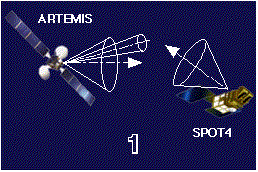 Following
the coarse pointing phase, the pointing error of each of the terminals is much greater
than the divergence angle of the communication beams and therefore requires that a lock-on
procedure be carried out.
Following
the coarse pointing phase, the pointing error of each of the terminals is much greater
than the divergence angle of the communication beams and therefore requires that a lock-on
procedure be carried out.![]()
page updated on the 05-07-05